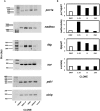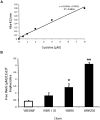An antioxidant response is involved in resistance of Giardia duodenalis to albendazole
- PMID: 25914688
- PMCID: PMC4392323
- DOI: 10.3389/fmicb.2015.00286
An antioxidant response is involved in resistance of Giardia duodenalis to albendazole
Abstract
Albendazole (ABZ) is a therapeutic benzimidazole used to treat giardiasis that targets β-tubulin. However, the molecular bases of ABZ resistance in Giardia duodenalis are not understood because β-tubulin in ABZ-resistant clones lacks mutations explaining drug resistance. In previous work we compared ABZ-resistant (1.35, 8, and 250 μM) and ABZ-susceptible clones by proteomic analysis and eight proteins involved in energy metabolism, cytoskeleton dynamics, and antioxidant response were found as differentially expressed among the clones. Since ABZ is converted into sulphoxide (ABZ-SO) and sulphone (ABZ-SOO) metabolites we measured the levels of these metabolites, the antioxidant enzymes and free thiols in the susceptible and resistant clones. Production of reactive oxygen species (ROS) and levels of ABZ-SO/ABZ-SOO induced by ABZ were determined by fluorescein diacetate-based fluorescence and liquid chromatography respectively. The mRNA and protein levels of antioxidant enzymes (NADH oxidase, peroxiredoxin 1a, superoxide dismutase and flavodiiron protein) in these clones were determined by RT-PCR and proteomic analysis. The intracellular sulfhydryl (R-SH) pool was quantified using dinitrobenzoic acid. The results showed that ABZ induced ROS accumulation in the ABZ-susceptible Giardia cultures but not in the resistant ones whilst the accumulation of ABZ-SO and ABZ-SOO was lower in all ABZ-resistant cultures. Consistent with these findings, all the antioxidant enzymes detected and analyzed were upregulated in ABZ-resistant clones. Likewise the R-SH pool increased concomitantly to the degree of ABZ-resistance. These results indicate an association between accumulation of ABZ metabolites and a pro-oxidant effect of ABZ in Giardia-susceptible clones. Furthermore the antioxidant response involving ROS-metabolizing enzymes and intracellular free thiols in ABZ-resistant parasites suggest that this response may contribute to overcome the pro-oxidant cytotoxicity of ABZ.
Keywords: Giardia duodenalis; albendazole; antioxidant enzymes; drug resistance; sulfhydryl pool.
Figures





Similar articles
-
Albendazole induces oxidative stress and DNA damage in the parasitic protozoan Giardia duodenalis.Front Microbiol. 2015 Aug 6;6:800. doi: 10.3389/fmicb.2015.00800. eCollection 2015. Front Microbiol. 2015. PMID: 26300866 Free PMC article.
-
Giardia duodenalis: Flavohemoglobin is involved in drug biotransformation and resistance to albendazole.PLoS Pathog. 2022 Sep 27;18(9):e1010840. doi: 10.1371/journal.ppat.1010840. eCollection 2022 Sep. PLoS Pathog. 2022. PMID: 36166467 Free PMC article.
-
In vitro resistance to 5-nitroimidazoles and benzimidazoles in Giardia duodenalis: variability and variation in gene expression.Infect Genet Evol. 2009 Dec;9(6):1057-64. doi: 10.1016/j.meegid.2009.05.015. Epub 2009 May 27. Infect Genet Evol. 2009. PMID: 19481175
-
The binding and distribution of albendazole and its principal metabolites in Giardia duodenalis.J Vet Pharmacol Ther. 2000 Jun;23(3):113-20. doi: 10.1046/j.1365-2885.2000.00254.x. J Vet Pharmacol Ther. 2000. PMID: 11110097 Review.
-
Anaerobic bacterial metabolism in the ancient eukaryote Giardia duodenalis.Int J Parasitol. 1998 Jan;28(1):149-64. doi: 10.1016/s0020-7519(97)00172-0. Int J Parasitol. 1998. PMID: 9504342 Review.
Cited by
-
Albendazole induces oxidative stress and DNA damage in the parasitic protozoan Giardia duodenalis.Front Microbiol. 2015 Aug 6;6:800. doi: 10.3389/fmicb.2015.00800. eCollection 2015. Front Microbiol. 2015. PMID: 26300866 Free PMC article.
-
gdSir2.1 and gdSir2.3 are involved in albendazole resistance in Giardia duodenalis via regulation of the oxidative stress response.Int J Parasitol Drugs Drug Resist. 2025 Aug;28:100596. doi: 10.1016/j.ijpddr.2025.100596. Epub 2025 May 5. Int J Parasitol Drugs Drug Resist. 2025. PMID: 40373730 Free PMC article.
-
In vitro selection of Giardia duodenalis for Albendazole resistance identifies a β-tubulin mutation at amino acid E198K.Int J Parasitol Drugs Drug Resist. 2021 Aug;16:162-173. doi: 10.1016/j.ijpddr.2021.05.003. Epub 2021 Jun 10. Int J Parasitol Drugs Drug Resist. 2021. PMID: 34237690 Free PMC article.
-
Giardia duodenalis: Flavohemoglobin is involved in drug biotransformation and resistance to albendazole.PLoS Pathog. 2022 Sep 27;18(9):e1010840. doi: 10.1371/journal.ppat.1010840. eCollection 2022 Sep. PLoS Pathog. 2022. PMID: 36166467 Free PMC article.
-
Resistance formation to nitro drugs in Giardia lamblia: No common markers identified by comparative proteomics.Int J Parasitol Drugs Drug Resist. 2019 Apr;9:112-119. doi: 10.1016/j.ijpddr.2019.03.002. Epub 2019 Mar 15. Int J Parasitol Drugs Drug Resist. 2019. PMID: 30889439 Free PMC article.
References
-
- Abboud P., Lemée V., Gargala G., Brasseur P., Ballet J. J., Borsa-Lebas F., et al. (2001). Successful treatment of metronidazole- and albendazole-resistant giardiasis with nitazoxanide in a patient with acquired immunodeficiency syndrome. Clin. Infect. Dis. 15 1792–1794 10.1086/320751 - DOI - PubMed
LinkOut - more resources
Full Text Sources
Other Literature Sources

